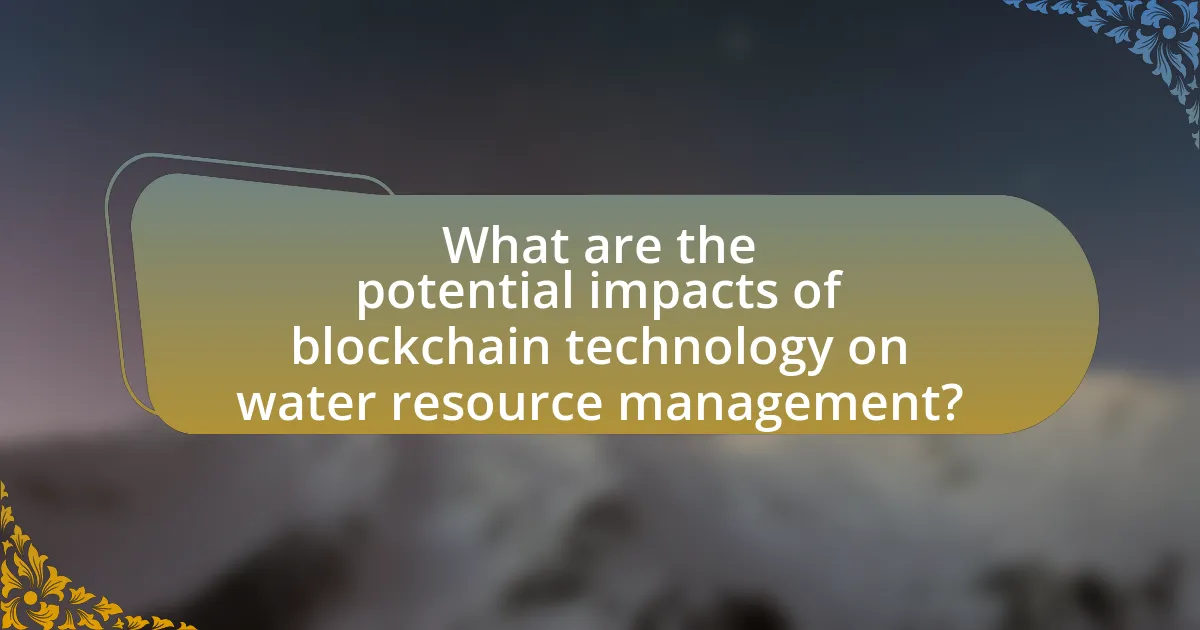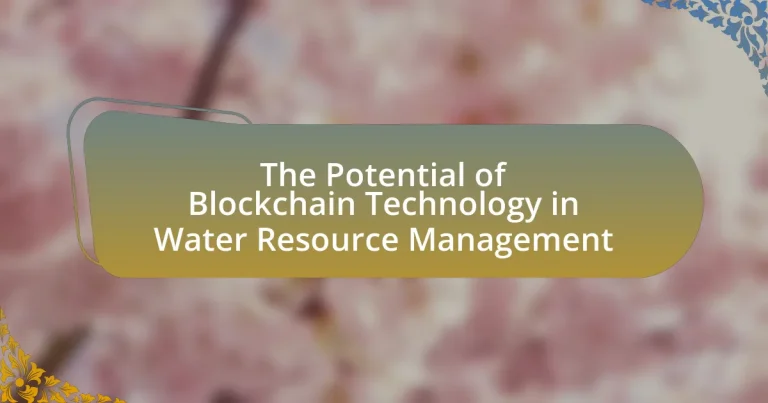The main entity of the article is blockchain technology and its application in water resource management. The article explores how blockchain can enhance transparency, efficiency, and accountability in water distribution and usage, addressing key challenges such as inadequate infrastructure and lack of data transparency. It discusses specific features of blockchain, including decentralized ledgers and smart contracts, that improve stakeholder trust and facilitate better data sharing. Additionally, the article highlights the potential environmental benefits, cost savings, and best practices for implementing blockchain solutions in water management, emphasizing the importance of collaboration among stakeholders to maximize these benefits.

What is the potential of blockchain technology in water resource management?
Blockchain technology has significant potential in water resource management by enhancing transparency, efficiency, and accountability in water distribution and usage. This technology enables real-time tracking of water resources, ensuring accurate data collection and sharing among stakeholders, which can lead to better decision-making. For instance, a study by the World Bank highlights that blockchain can facilitate decentralized water management systems, allowing users to monitor water quality and usage patterns effectively. Additionally, smart contracts on blockchain can automate billing and compliance processes, reducing administrative costs and errors. These capabilities demonstrate that blockchain can transform water resource management into a more sustainable and equitable system.
How can blockchain technology improve transparency in water resource management?
Blockchain technology can improve transparency in water resource management by providing a decentralized and immutable ledger that records all transactions related to water usage and distribution. This transparency allows stakeholders, including governments, water utilities, and consumers, to access real-time data on water allocation, usage patterns, and quality metrics. For instance, a study by the World Bank highlights that blockchain can enhance accountability by enabling traceability of water rights and usage, thereby reducing corruption and mismanagement. Additionally, smart contracts on blockchain can automate compliance with regulations, ensuring that water management practices adhere to established standards, further promoting transparency.
What specific features of blockchain enhance transparency in water management?
Blockchain enhances transparency in water management through its decentralized ledger, immutability, and real-time data sharing features. The decentralized ledger allows multiple stakeholders to access the same information, reducing the risk of data manipulation. Immutability ensures that once data is recorded, it cannot be altered, providing a reliable historical record of water usage and management activities. Real-time data sharing facilitates immediate access to information regarding water quality, availability, and distribution, enabling stakeholders to make informed decisions. These features collectively promote accountability and trust among users, as evidenced by pilot projects in various regions that have successfully implemented blockchain for tracking water resources and usage.
How does transparency impact stakeholder trust in water resource management?
Transparency significantly enhances stakeholder trust in water resource management by providing clear, accessible information regarding water usage, allocation, and quality. When stakeholders, including communities and regulatory bodies, can easily access data and understand decision-making processes, they are more likely to feel confident in the management practices. Research indicates that transparency reduces information asymmetry, which fosters accountability and encourages stakeholder engagement. For instance, a study by the World Bank found that transparent water management practices lead to increased public trust and participation, ultimately resulting in more sustainable water resource outcomes.
What are the key challenges in current water resource management practices?
The key challenges in current water resource management practices include inadequate infrastructure, inefficient allocation of resources, and lack of data transparency. Inadequate infrastructure leads to significant water losses, with estimates suggesting that up to 30% of water is lost through leaks in urban systems. Inefficient allocation often results from outdated policies and practices that do not reflect current demand or environmental conditions, exacerbating water scarcity in many regions. Additionally, lack of data transparency hinders effective decision-making, as stakeholders may not have access to real-time information about water availability and usage, which is critical for sustainable management. These challenges highlight the need for innovative solutions, such as blockchain technology, to enhance efficiency and accountability in water resource management.
How do inefficiencies in water distribution affect resource management?
Inefficiencies in water distribution significantly hinder effective resource management by leading to water loss, increased costs, and inequitable access. For instance, according to the World Bank, approximately 30% of water is lost in distribution systems due to leaks and inefficiencies, which exacerbates scarcity and raises operational expenses. This loss not only strains financial resources but also limits the availability of water for agricultural, industrial, and domestic use, ultimately impacting economic development and sustainability. Furthermore, inefficient distribution can create disparities in access, where some communities receive inadequate water supply while others waste resources, highlighting the need for improved management strategies.
What role does data integrity play in water resource management challenges?
Data integrity is crucial in addressing water resource management challenges as it ensures the accuracy and reliability of data used for decision-making. Accurate data enables effective monitoring of water quality, availability, and usage, which are essential for sustainable management practices. For instance, a study by the World Bank highlights that poor data integrity can lead to misallocation of resources, resulting in water scarcity or pollution. Furthermore, implementing blockchain technology can enhance data integrity by providing a transparent and immutable record of water-related transactions, thereby fostering trust among stakeholders and improving overall management efficiency.
Why is blockchain technology considered a solution for these challenges?
Blockchain technology is considered a solution for challenges in water resource management due to its ability to provide transparency, traceability, and security in data management. By utilizing a decentralized ledger, blockchain ensures that all transactions related to water usage and distribution are recorded in an immutable manner, which reduces the risk of fraud and mismanagement. For instance, a study by the World Economic Forum highlights that blockchain can enhance the efficiency of water distribution systems by enabling real-time monitoring and management of water resources, thereby improving accountability among stakeholders. This capability to track water usage and quality in a transparent manner addresses issues such as water scarcity and pollution, making blockchain a viable solution for enhancing water resource management.
What advantages does blockchain offer over traditional water management systems?
Blockchain offers enhanced transparency, security, and efficiency over traditional water management systems. By utilizing a decentralized ledger, blockchain allows for real-time tracking of water usage and distribution, which reduces the potential for fraud and mismanagement. For instance, a study by the World Economic Forum highlights that blockchain can improve data integrity and accountability in water resource management, leading to better decision-making and resource allocation. Additionally, smart contracts on blockchain can automate processes such as billing and compliance, further streamlining operations and reducing administrative costs.
How can blockchain facilitate better data sharing among stakeholders?
Blockchain can facilitate better data sharing among stakeholders by providing a decentralized and immutable ledger that ensures transparency and trust. This technology allows multiple parties to access and verify data in real-time without the need for a central authority, reducing the risk of data manipulation. For instance, in water resource management, stakeholders such as government agencies, water suppliers, and consumers can share data on water usage and quality seamlessly. A study by the World Economic Forum highlights that blockchain can enhance collaboration among stakeholders by enabling secure and efficient data exchange, ultimately leading to improved decision-making and resource allocation.

What specific applications of blockchain technology exist in water resource management?
Blockchain technology has specific applications in water resource management, including water quality monitoring, efficient water trading, and enhanced transparency in water usage. For instance, blockchain can facilitate real-time tracking of water quality data, ensuring that stakeholders have access to accurate information about contamination levels, which is crucial for public health and regulatory compliance. Additionally, blockchain enables decentralized water trading platforms, allowing users to buy and sell water rights securely and transparently, thus optimizing resource allocation. Furthermore, the immutable nature of blockchain records enhances transparency in water usage, helping to prevent fraud and ensuring that water conservation efforts are accurately documented and verified. These applications demonstrate how blockchain can improve efficiency, accountability, and sustainability in managing water resources.
How can smart contracts be utilized in water management?
Smart contracts can be utilized in water management by automating and enforcing agreements related to water usage, distribution, and quality monitoring. These self-executing contracts, built on blockchain technology, ensure transparency and accountability among stakeholders, such as water suppliers, consumers, and regulatory bodies. For instance, smart contracts can automatically release payments based on real-time water usage data, reducing disputes and ensuring timely transactions. Additionally, they can facilitate compliance with environmental regulations by automatically triggering penalties for violations, thus promoting sustainable water practices. The implementation of smart contracts in water management has been supported by studies indicating that blockchain can enhance operational efficiency and reduce costs in resource management.
What are the benefits of using smart contracts for water allocation?
Smart contracts enhance water allocation by automating and securing transactions, ensuring transparency and efficiency. They eliminate the need for intermediaries, reducing costs and time associated with water distribution. Additionally, smart contracts enable real-time monitoring of water usage, allowing for precise allocation based on demand and availability. This technology also fosters trust among stakeholders by providing an immutable record of transactions, which can be audited and verified. Studies indicate that implementing smart contracts in water management can lead to significant improvements in resource allocation efficiency, as evidenced by pilot projects in various regions demonstrating reduced wastage and improved compliance with water usage regulations.
How do smart contracts ensure compliance with water usage regulations?
Smart contracts ensure compliance with water usage regulations by automating the enforcement of rules and conditions set forth in legal agreements. These self-executing contracts operate on blockchain technology, which provides a transparent and immutable record of water usage data. For instance, smart contracts can automatically monitor water consumption against predefined limits, triggering penalties or alerts if usage exceeds regulatory thresholds. This real-time monitoring is supported by IoT devices that collect data on water flow and usage patterns, ensuring accurate compliance tracking. The integration of these technologies has been shown to reduce violations and enhance accountability in water resource management, as evidenced by pilot projects in various regions that have successfully implemented smart contracts to regulate agricultural water use.
What role does IoT play in enhancing blockchain applications in water management?
IoT significantly enhances blockchain applications in water management by providing real-time data collection and monitoring capabilities. This integration allows for accurate tracking of water usage, quality, and distribution, which is essential for efficient resource management. For instance, IoT sensors can monitor water levels and quality in reservoirs, transmitting this data to a blockchain system that ensures transparency and immutability of records. This combination facilitates better decision-making and accountability among stakeholders, as evidenced by projects like the WaterChain initiative, which utilizes IoT data to optimize water distribution and reduce waste.
How can IoT devices improve data collection for blockchain systems?
IoT devices can enhance data collection for blockchain systems by providing real-time, accurate, and automated data inputs. These devices, such as smart sensors and meters, continuously monitor environmental conditions and resource usage, generating data that can be directly recorded on a blockchain. For instance, in water resource management, IoT sensors can track water quality and consumption levels, ensuring that the data is immutable and transparent on the blockchain. This integration not only increases the reliability of the data collected but also facilitates better decision-making and resource allocation, as evidenced by projects like the Water Management System in Singapore, which utilizes IoT and blockchain for efficient water resource tracking.
What are the implications of real-time data on water resource management?
Real-time data significantly enhances water resource management by enabling timely decision-making and efficient resource allocation. This immediacy allows for the monitoring of water quality and quantity, facilitating rapid responses to changes such as contamination events or drought conditions. For instance, real-time data can lead to a 30% reduction in water loss through better leak detection and management, as evidenced by studies conducted in urban water systems. Furthermore, integrating real-time data with blockchain technology can ensure data integrity and transparency, fostering trust among stakeholders and improving collaborative efforts in water management.
How can blockchain technology support water quality monitoring?
Blockchain technology can support water quality monitoring by providing a decentralized and immutable ledger for recording water quality data. This ensures transparency and traceability, allowing stakeholders to access real-time information about water conditions. For instance, sensors can collect data on parameters such as pH, turbidity, and contaminants, which can then be securely logged on the blockchain. This method enhances data integrity, as any tampering would be easily detectable due to the nature of blockchain. Additionally, studies have shown that blockchain can facilitate collaboration among various entities, such as government agencies, NGOs, and local communities, by enabling them to share and verify data efficiently, thus improving overall water management practices.
What methods can be used to integrate blockchain with water quality data?
Blockchain can be integrated with water quality data through methods such as decentralized data storage, smart contracts, and IoT sensor integration. Decentralized data storage allows for secure and tamper-proof records of water quality metrics, ensuring data integrity. Smart contracts can automate compliance and reporting processes, triggering actions based on predefined water quality thresholds. IoT sensors can continuously monitor water quality parameters and feed real-time data into the blockchain, enhancing transparency and accountability. These methods collectively enhance data reliability and facilitate better decision-making in water resource management.
How does blockchain enhance accountability in water quality management?
Blockchain enhances accountability in water quality management by providing a transparent and immutable ledger for tracking water quality data. This technology allows stakeholders, including regulators, water suppliers, and consumers, to access real-time information about water quality metrics, ensuring that data cannot be altered or tampered with. For instance, a study by the World Economic Forum highlights that blockchain can facilitate the secure sharing of water quality data among various parties, thereby increasing trust and compliance with regulatory standards. By enabling traceability of water quality from source to consumer, blockchain fosters greater responsibility among water management entities, ultimately leading to improved public health outcomes and environmental protection.

What are the potential impacts of blockchain technology on water resource management?
Blockchain technology can significantly enhance water resource management by improving transparency, efficiency, and accountability in water distribution and usage. By utilizing decentralized ledgers, stakeholders can track water usage in real-time, ensuring accurate billing and reducing wastage. For instance, a study by the International Water Association highlights that blockchain can facilitate smart contracts for water rights, enabling automated and transparent transactions that minimize disputes. Additionally, blockchain’s immutable records can enhance data integrity, allowing for better regulatory compliance and resource allocation. These impacts collectively contribute to more sustainable water management practices.
How can blockchain technology lead to cost savings in water management?
Blockchain technology can lead to cost savings in water management by enhancing transparency and efficiency in water distribution and usage tracking. By utilizing smart contracts, water management systems can automate billing and reduce administrative costs associated with manual processes. For instance, a study by the World Economic Forum highlights that blockchain can minimize water loss through real-time monitoring and data sharing, which can save utilities up to 30% in operational costs. Additionally, decentralized data storage reduces the risk of fraud and errors, further lowering expenses related to water management.
What specific areas of water management can benefit from reduced costs?
Water management can benefit from reduced costs in areas such as infrastructure maintenance, leak detection, and water quality monitoring. For instance, implementing blockchain technology can streamline infrastructure maintenance by providing real-time data on asset conditions, which reduces the need for costly repairs and extends asset lifespan. Additionally, blockchain can enhance leak detection systems by enabling more efficient tracking of water flow and usage, leading to quicker identification of leaks and minimizing water loss. Furthermore, blockchain can improve water quality monitoring by ensuring transparent and tamper-proof records of water quality data, which can reduce the costs associated with compliance and regulatory reporting. These applications demonstrate how reduced costs in these specific areas can lead to more efficient and sustainable water management practices.
How does cost reduction affect overall water accessibility?
Cost reduction significantly enhances overall water accessibility by lowering the financial barriers for consumers and service providers. When costs associated with water supply and infrastructure are reduced, more individuals and communities can afford access to clean water. For instance, a study by the World Bank indicates that reducing water service costs by 20% can increase access to water for up to 30% more households in low-income areas. Additionally, cost-effective technologies, such as those enabled by blockchain, can streamline operations and reduce waste, further improving accessibility.
What are the environmental benefits of implementing blockchain in water resource management?
Implementing blockchain in water resource management offers significant environmental benefits, including enhanced transparency, improved water conservation, and efficient resource allocation. Blockchain technology enables real-time tracking of water usage and quality, which helps identify leaks and inefficiencies in distribution systems, ultimately reducing water waste. For instance, a study by the World Economic Forum highlights that blockchain can facilitate decentralized water management, allowing communities to monitor their water resources more effectively and make informed decisions based on accurate data. This increased accountability can lead to more sustainable practices and better compliance with environmental regulations, contributing to the overall health of ecosystems reliant on water resources.
How can blockchain contribute to sustainable water usage practices?
Blockchain can contribute to sustainable water usage practices by enhancing transparency and accountability in water resource management. By utilizing decentralized ledgers, stakeholders can track water usage in real-time, ensuring that consumption aligns with sustainable practices. For instance, smart contracts can automate water allocation based on predefined criteria, reducing waste and promoting equitable distribution. A study by the World Bank highlights that blockchain can improve data integrity and accessibility, which is crucial for effective water management strategies. This technology enables better monitoring of water quality and availability, facilitating informed decision-making that supports sustainability goals.
What role does blockchain play in promoting conservation efforts?
Blockchain plays a crucial role in promoting conservation efforts by enhancing transparency and traceability in resource management. This technology allows stakeholders to securely record and share data regarding resource usage, ensuring that conservation practices are monitored and verified. For instance, blockchain can track water usage in agricultural practices, enabling farmers to adopt sustainable methods while providing proof of compliance with conservation regulations. A study by the World Wildlife Fund highlights that blockchain can improve accountability in water management, leading to better conservation outcomes by reducing waste and promoting efficient resource allocation.
What are the best practices for implementing blockchain technology in water resource management?
The best practices for implementing blockchain technology in water resource management include ensuring data integrity, fostering stakeholder collaboration, and utilizing smart contracts. Data integrity is achieved through the immutable nature of blockchain, which guarantees that water usage and quality data remain accurate and tamper-proof. Stakeholder collaboration is essential, as involving water authorities, consumers, and technology providers can enhance transparency and trust in the system. Smart contracts automate processes such as billing and compliance, reducing administrative overhead and increasing efficiency. These practices are supported by case studies, such as the use of blockchain in the water supply chain in Dubai, which demonstrated improved accountability and resource allocation.
What steps should organizations take to adopt blockchain solutions effectively?
Organizations should take the following steps to adopt blockchain solutions effectively: first, they must identify specific use cases that align with their operational goals, such as improving transparency in water resource management. Next, organizations should conduct a thorough assessment of their existing infrastructure to determine compatibility with blockchain technology. Following this, they should engage stakeholders, including regulatory bodies and technology partners, to ensure collaborative development and compliance with legal frameworks. Additionally, organizations need to invest in training and education for their teams to build blockchain expertise. Finally, they should implement pilot projects to test the technology in real-world scenarios, allowing for iterative improvements based on feedback and performance metrics. These steps are supported by the increasing adoption of blockchain in various sectors, demonstrating its potential to enhance efficiency and accountability in resource management.
How can stakeholders collaborate to maximize the benefits of blockchain in water management?
Stakeholders can collaborate to maximize the benefits of blockchain in water management by establishing a shared platform that integrates data from various sources, ensuring transparency and accountability. This collaboration can involve water utilities, government agencies, environmental organizations, and technology providers working together to create a decentralized ledger that tracks water usage, quality, and distribution in real-time. For instance, the use of smart contracts can automate compliance with regulations and facilitate efficient resource allocation, as demonstrated in pilot projects like the one conducted by the World Bank in 2020, which showcased improved water management through blockchain technology. By sharing data and insights, stakeholders can enhance decision-making processes, reduce operational costs, and promote sustainable water practices.


